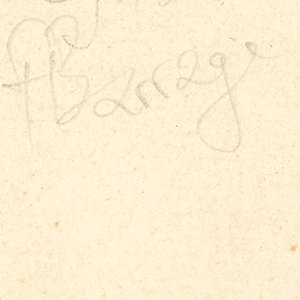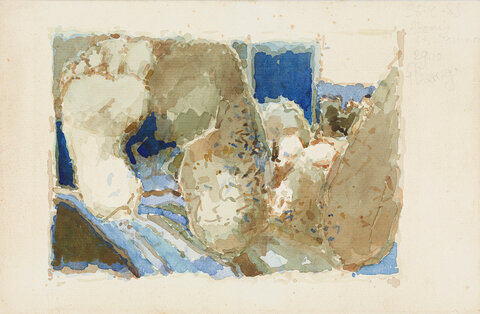Lebanese artist Fadi Barrage was born in 1940; he was among the first generation of artists who emerged during Beirut’s growing art scene between the late 1960s to 1980s. Barrage began his artistic...


FADI BARRAGE, Lebanon (1940 - 1988)
Bio
Written by CHRISTINE LABBAN
Lebanese artist Fadi Barrage was born in 1940; he was among the first generation of artists who emerged during Beirut’s growing art scene between the late 1960s to 1980s. Barrage began his artistic journey in Beirut, Lebanon, and pursued further education in the United States, studying at Chicago University and the Art Institute of Chicago from 1960 to 1964 1.
Upon completing his studies in the United States, Barrage's quest for artistic expression led him to Paris, where he resided from 1964 to 1968. His artistic journey back to Lebanon, led him to actively participate in various group exhibitions across Lebanon, France, Saudi Arabia, Tokyo (1970), and Jordan 2 . His education in the West and returning to live in the Beirut art scene helped bridge the gap between the artistic schools of the east and west. In 1971, he exhibited his work at Gallery One in Beirut, followed by participation in the Salon des Peintres Témoins de leur Temps in Beirut in 1972 and 1973. His artistic contributions were internationally recognized, when his work was showcased at the Contemporary Lebanese Artists exhibition held at the Kufa Gallery, in London, in 1988.
Barrage's artistic style defied simple categorization. His work is marked by an eclectic blend of influences, including his interest in ancient languages, particularly Greek, as well as literature, science, and the profound influence of the German painter Paul Klee. His art seamlessly weaves between various styles, from Naturalism to Impressionism, Abstract Expressionism, and Cubism. Often, his works elude straightforward classification, residing in the delicate balance between abstraction and realism.
The versatility and depth of Barrage's work, which straddled the line between diverse artistic movements and personal passions, set the stage for a profound shift when faced with the upheavals of his time. The outbreak of the Lebanese Civil War brought immense challenges to his life and art. His studio in Bab Idriss, Beirut, was destroyed, and hundreds of his artworks were lost. Despite these setbacks, Barrage displayed unyielding determination. He embarked on a journey of self-imposed exile, residing in Egypt, Turkey, Greece, and Cyprus. Nonetheless, Barrage continued to paint throughout this tumultuous period.
The artwork produced during the 1980s primarily focused on watercolors, depicting interior scenes, still-lifes, and occasional representations of erotic fantasies. His style revolved around the use of lines to delineate features, which he would later blur in a playful fusion of abstraction and realism. This approach aimed to convey a sense of loneliness and isolation, capturing the complex emotions of the human experience. 3 Untitled, 1987 from the Saradar Collection 4 , depicts a vase of white and pink cyclamens with a solemn yellow flower in the center. Barrage used watercolor and gouache to paint the vase of cyclamen, that was exhibited as part of a series in the Epreuve d'Artiste Gallery, in Kaslik, 1987-1988. Art critic, Joseph Tarrab, attributed the flowers to the concept of rebirth, since cyclamens only bloom in winter. Barrage's work was a manifestation of his inner struggles, often reflecting the anxieties and demons he carried, much like his admired artist, Paul Klee.
Fadi Barrage's general oeuvre encompasses a diverse range of subjects, incorporating geometric shapes and personal symbols. His works contain figurative elements, which he deconstructed in a Cubist fashion. The watercolor and gouache painting Untitled, 1986 5 , also located in the Saradar Collection, presents two squares in ochre and white, placed on top of each other, against a blue rectangular background. The synthesis of unconventional and often whimsical elements like the incoherent scribbles that mimic Hellenistic writing, served an intuitive purpose. Barrage used various symbols, encompassing lines, squares, rectangles and stains, evoking a rich depiction of emotions and ideas. Depicting different sized squares with some being incomplete, arranged in ways that eventually carved a path out into the infinite, he painted a visual open road to nothingness. Barrage reconciled antagonisms in his work, through the union of opposites, even when reduced to only the canvas's surface. The Untitled, 1986, which is part of the Saradar Collection, was described by Tarrab as a chronicling of his illness until his surrendering to it.
Barrage’s palette of subdued tones reflects themes of mud, sun, skin, lips, and flesh. His work frequently featured portraits, where the juxtaposition of faces with naked or decapitated male bodies conveyed deep-seated emotions and reflections on life, war, and death. This can be seen in the water-colour painting Adonis/Homme Couché, 1985 6 , housed at the Ramzi and Saeda Dalloul Art Foundation, in Beirut. The use of earthy tones – mossy green, muddied white, and hues of blue – adds a mortal element evident in the painting, a subject the artist often tackled about his own life. Barrage introduces a naked man’s body, beginning with his feet in the forefront, and ending with his head at the top of the canvas. This foreshortening technique results in a perspective where the viewer is looking up from a lower position – an angle that is humbling and quite intimate. Barrage’s work always challenged the barriers and taboos of his geographical location. His commitment to art was unwavering, even in the face of personal hardships and a world torn by conflict.
Fadi Barrage's life was cut short by a long-term illness, and he passed away in Athens, Greece, in 1988. His artistic journey remains a testament to the power of creativity in the face of adversity. In the words of writer and art critic, Joseph Tarrab,
"Whoever knew Fadi before 1975 can't separate him from his spontaneous questions and discussions and choices of isolation, as a response to an inner need that doesn't find its freedom except in free touch and free creation”. 7
Edited by Wafa Roz & Elsie Labban
Sources:
One Fine Art | Artists - Painters / Fadi Barrage.” n.d. Www.onefineart.com. Accessed October 16, 2023.www.onefineart.com
“5 de Pic - Fadi Barrage.” n.d. Www.youtube.com. Accessed October 16, 2023.
فيصل سلطان. (2013). كتابات مستعادة من ذاكرة فنون بيروت. دار الفارابي.
“Saradar Collection | Collection Details.” n.d. Saradar Collection. Accessed October 28, 2023. www.saradarcollection.com
Saradar Collection | Collection Details.” n.d. Saradar Collection. Accessed October 16, 2023. www.saradarcollection.com
Adonis/Homme Couché by FADI BARRAGE.” n.d. Dalloul Art Foundation. Accessed October 16, 2023. dafbeirut.org/en/fadi
One Fine Art | Internal Page - Fadi Barrage / Fadi Barrage Passed Away.” n.d. Www.onefineart.com. Accessed October 16, 2023. www.onefineart.com
1 “One Fine Art | Artists - Painters / Fadi Barrage.” n.d. Www.onefineart.com. Accessed October 16, 2023. www.onefineart.com
2 “5 de Pic - Fadi Barrage.” n.d. Www.youtube.com. Accessed October 16, 2023.
3 فيصل سلطان. (2013). كتابات مستعادة من ذاكرة فنون بيروت. دار الفارابي.
4 “Saradar Collection | Collection Details.” n.d. Saradar Collection. Accessed October 28, 2023. www.saradarcollection.com
5 “Saradar Collection | Collection Details.” n.d. Saradar Collection. Accessed October 16, 2023. www.saradarcollection.com
6 “Adonis/Homme Couché by FADI BARRAGE.” n.d. Dalloul Art Foundation. Accessed October 16, 2023. dafbeirut.org/en/fadi
7 “One Fine Art | Internal Page - Fadi Barrage / Fadi Barrage Passed Away.” n.d. Www.onefineart.com. Accessed October 16, 2023. www.onefineart.com
CV
Selected Group Exhibitions
2022
The Doche, Séraphim & Barrage: A Search For The Fantastic, Agial Art Gallery, Beirut, Lebanon
2019
(Nothing But) Flowers, Saleh Barakat Gallery, Beirut, Lebanon
2013
Tajreed, A selection of Arab Abstract Art 1908 – 1960, CAP Kuwait, Kuwait City, Kuwait
FADI BARRAGE Artwork
Become a Member
Join us in our endless discovery of modern and contemporary Arab art
Become a Member
Get updates from DAF
Follow Artists
Save your favourite Artworks
Share your perspectives on Artworks
Be part of our community
It's Free!
We value your privacy
TermsCookiesPrivacy Policies
Become a Member
Get updates from DAF
Follow Artists
Save your favourite Artworks
Share your perspectives on Artworks
Be part of our community
It's Free!
We value your privacy
TermsCookiesPrivacy Policies
Become a Member
Get updates from DAF
Follow Artists
Save your favourite Artworks
Share your perspectives on Artworks
Be part of our community
It's Free!
We value your privacy
TermsCookiesPrivacy Policies
Welcome to the Dalloul Art Foundation
Thank you for joining our community
If you have entered your email to become a member of the Dalloul Art Foundation, please click the button below to confirm your email and agree to our Terms, Cookie & Privacy policies.
We value your privacy, see how
Become a Member
Get updates from DAF
Follow Artists
Save your favourite Artworks
Share your perspectives on Artworks
Be part of our community
It's Free!
We value your privacy
TermsCookiesPrivacy Policies




